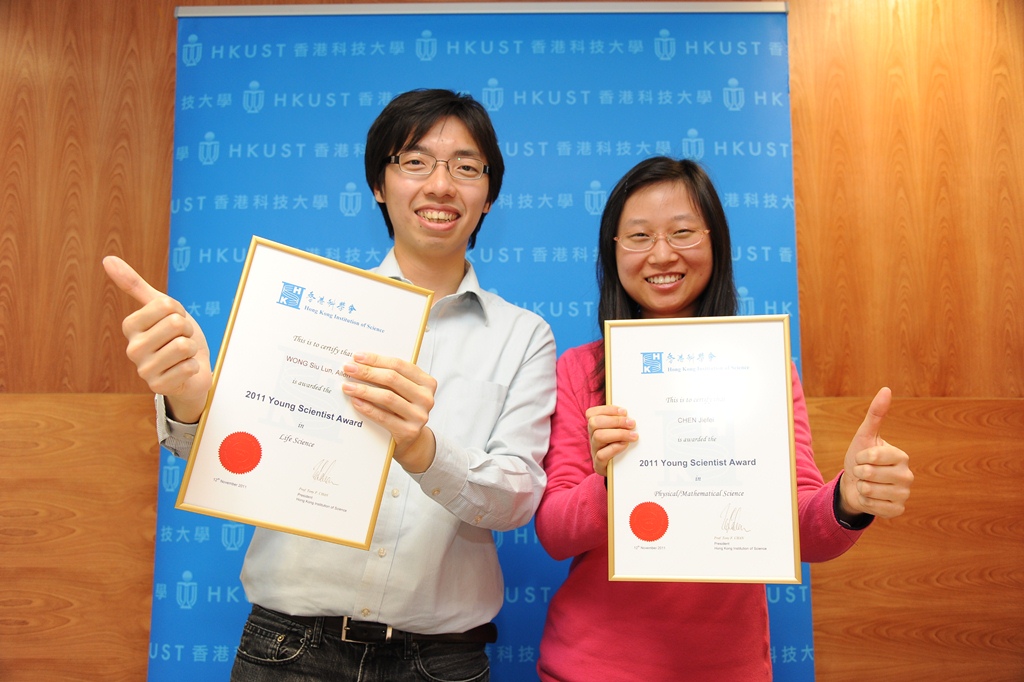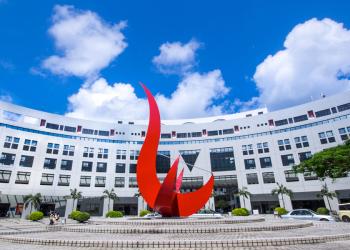HKUST Sweeps All 2011 Young Scientist Awards
Four PhD students from the Schools of Science and Engineering of the Hong Kong University of Science and Technology (HKUST) sweep all the 2011 Young Scientists Awards under the three categories of Physical / Mathematical Science, Life Science and Engineering Science this year.
Established by Hong Kong Institution of Science for its 10th year, the Hong Kong Young Scientist Awards recognize and honor young scientists and engineers in Hong Kong who excel and exhibit great promise in their field of study and promote science and technology development in the region. This year's competition received a total of 65 applications. After rigorous review by individual panels formed by distinguished experts and scholars, Ms Chen Jiefei from the Department of Physics, Mr Alan Wong Siu-lun and Mr Wu Lin from the Division of Life Sciences, and Mr Li Dong from the Department of Electronic and Computer Engineering were declared winners of the Awards.
Prof Tony F Chan, President of HKUST, is greatly pleased with the students' impressive achievements. He said, "As a world-class research university, HKUST has put heavy emphasis on fostering quality teaching and research and cultivating the finest young talents. We provide a wide array of platforms with countless opportunities on offer to unleash the potential in our young people and help them reach new heights. I take pride in our four PhD students who win all the Awards this year. HKUST will redouble its efforts to promote science and technology research with its innovative spirit."
The profiles of the four winners of the 2011 Young Scientists Awards are:
Winner in Physical / Mathematical Science
Ms Chen Jiefei, Department of Physics
Reaffirming Einstein's Theory
Ms Jiefei Chen has published eight papers and her award-winning study is titled Manipulate classical and quantum light with cold atoms. The wave-particle duality of light implies that light is wave while is composed of discrete energy packet called photons. In terms of wave propagation, Ms Chen and her research team have shown that the optical precursor is the fastest part which carries information and propagates with speed of light in vacuum c. A single photon is not ruled out by quantum mechanics to travel faster than the speed limit in the classical world. With the direct observation of optical precursor of a single photon, Ms Chen and her research team proved that single photons cannot travel faster than the speed of light in vacuum. The research outcome reaffirms Einstein's theory that nothing travels faster than light-in-vacuum and closes a decade-long debate about the speed of a single photon.
Winners in Life Science
Mr Alan Wong Siu-lun, Division of Life Sciences
Understanding Parkinson's disease
Mr Alan Siu-lun Wong has published seven papers and his award-winning study is titled Cdk5-mediated phosphorylation of endophilin B1 is required for induced autophagy in models of Parkinson's disease. Parkinson's disease (PD) is the most common neurodegenerative movement disorder. Despite its prevalence, current treatments only provide symptomatic relief, and therapeutics for halting disease progression is lacking. PD is caused by the selective death of neurons in a region of the brain known as substantia nigra, but much less is known concerning the cellular processes and molecular pathways that lead to their mysterious death. Mr Wong and his research team has made a breakthrough discovery by demonstrating that autophagy, a process that is typically required for recycling of cellular components, is abnormal in PD. They identified two molecules, Cdk5 and endophilin B1, which work together to mediate excessive induction of autophagy in these diseased neurons, leading to cell death. This pathway serves as a novel target for future development of therapeutics against PD, and was published this year in Nature Cell Biology, a prestigious journal in cell biology.
Mr Wu Lin, Division of Life Sciences
Understanding Deaf-Blindness
Mr Lin Wu has published three papers and his award-winning study is titled Functional and structural characterization of the Usher Syndrome I protein complexes. Usher syndrome is the most frequent cause of deaf-blindness. Five genes (Cdh23, harmonin, myo7a, sans and Pcdh15) have been identified as USH1 genes, the mutations of which lead to severe development defects of inner ear hair cells and RPE cells. After a series of biochemical and structural studies, Mr Lin and his research team specified the role and the relationship of four USH I genes in inner ear hair cell development and function. Cdh23 and harmonin form large protein complex, serving to maintain the structural integrity of hair cell stereocilia bundle under sound waves impacts. Sans interacts with both proteins and functions as the adaptor protein in myo7a-mediated harmonin transport in stereocilia. On top of the study on protein structures, their research discoveries also unveil on the molecular plane how genetic mutations trigger protein inactivation, which leads to anomaly in inner ear hair cells development and hence deafness.
Winner in Engineering Science
Mr Li Dong, Department of Electronic & Computer Engineering
Observing and Understanding Microcosm Through Advanced Nonlinear Optical Imaging Technology
Mr Li Dong has published 12 papers and his award-winning study is titled Advanced nonlinear optical imaging technology for biomedical applications. For centuries, optical microscopy has greatly facilitated our observation and understanding of microcosm. The innovation of optical microscopy technology has been always the driving force behind the major developments in biological science and medicine. His PhD dissertation developed a variety of label-free and multi-modal nonlinear optical (NLO) microscopy technologies, successfully utilizing the supercontinuum light to excite multiple NLO signals while keep the NLO microscopy easy operating and cost-effective. Mr Li and his research team also developed a unique time- and spectral-resolved detection system to capture multiple NLO signals simultaneously. With the advanced NLO microscope technologies, they discovered new natural NLO signals that can serve as the contrast agent for imaging the biological and medical specimens and provide valuable diagnostic information. These innovations open a new window to investigate the biological and medical problems from multiple points of view.
The Hong Kong Institution of Science was established in 1992 to foster the development of science in Hong Kong and to facilitate the development of links with scientific communities in the Chinese mainland, Taiwan and overseas. The Institution has nearly 400 members covering the fields of physical science, life science, engineering science and mathematics. It has been taking an active role in supporting the development of innovation and technology in Hong Kong.
For media enquiries, please feel free to contact :
Mavis Wong
Tel: 2358 6306
Email: maviswong@ust.hk









